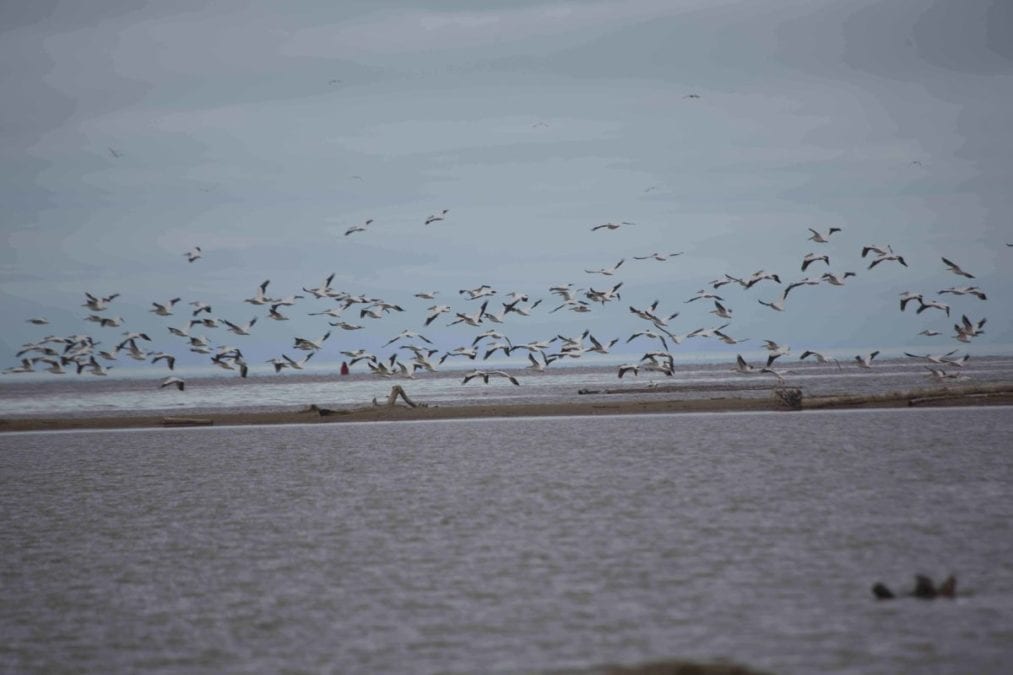
Photo courtesy of Gary Vizniowski
For the past several weeks, birdwatchers in Hay River and everyone else have been treated to the sight of an extraordinary number of pelicans
"I'd never seen such a big flock," said birdwatcher Bruce Green of when he saw the pelicans in the area of the Hay River Beach. "It looked like all the pelicans in the North were at the mouth of the river there."
Green said the largest part of flock was lined up at the mouth of the river and it looked like they were fishing.
"So it was easy to count them. There were over a hundred in that group, and then there were some out on the sandbar, another 50 or so. And then there were another 50 or so in another area of the water down there. I think there were at least 200 birds."
Green noted the birds – American white pelicans – have been around for a while this summer.
"I mean it's not unusual to see them down there," he said of the beach area. "Almost every year they put in an appearance for a few days at least, but I've never seen these numbers before."
Green doesn't have an explanation for the high numbers, but he speculated high water levels at the pelican colony on the Slave River at Fort Smith may have interrupted their normal fishing areas.
"Maybe the currents are too strong there or something," he said. "That would be one possibility. Maybe there's something impacting their food supply, or maybe the fish that they like to feed on are showing up here. There's got to be an explanation for it, but I don't have it."
As a birdwatcher, Green has enjoyed seeing the pelicans.
"They are quite amazing birds," he said. "It's always lovely to see them."
Gary Vizniowski, another birdwatcher in Hay River, counted 42 pelicans at the forks in the middle of last week.
"The biggest flock I saw was down at the beach a few weeks ago," he said, noting he counted about 140 pelicans.
Vizniowski said he has not seen that number of pelicans before in Hay River.
"The most I've seen before is like two dozen," he said. "So this year seeing the numbers there are to me unusual."
Vizniowski said his understanding is that the pelicans are juveniles not of breeding age, and less tied to the breeding area in the rapids on the Slave River.
Fort Smith's John McKinnon, a volunteer with the Pelican Advisory Circle, said the assumption is that the pelicans in Hay River are associated with the Slave River colony.
McKinnon noted there has been extremely high water on the Slave River since breakup – the highest levels since the late 1990s – and that means the pelicans' typical resting spots on rocks and islands are covered by water at the Rapids of the Drowned, one of the birds' main feeding sites.
"So I think the birds are going to new places that they don't normally do," he explained. "And one thing about pelicans is where there's pelicans there's fish, and where there's fish there's pelicans. And so there's definitely fish that they found there in the Hay River."
McKinnon said the pelicans in Hay River are most likely juveniles – aged from one to three years – and there could even be some adults catching fish to bring back to chicks in nests on the Slave River.
"Pelicans have been known to travel upwards of 700 km in a return trip from their colony," he said. "Going up to 350 km away from their colony to fish and then flying back 350 km to deliver those fish to their chicks."
McKinnon said it is great that pelicans are being seen in more places this year, including Wrigley and Kugluktuk, Nunavut.
"People shouldn't worry about the birds," he said. "Just be taking in their beauty and enjoy the show."